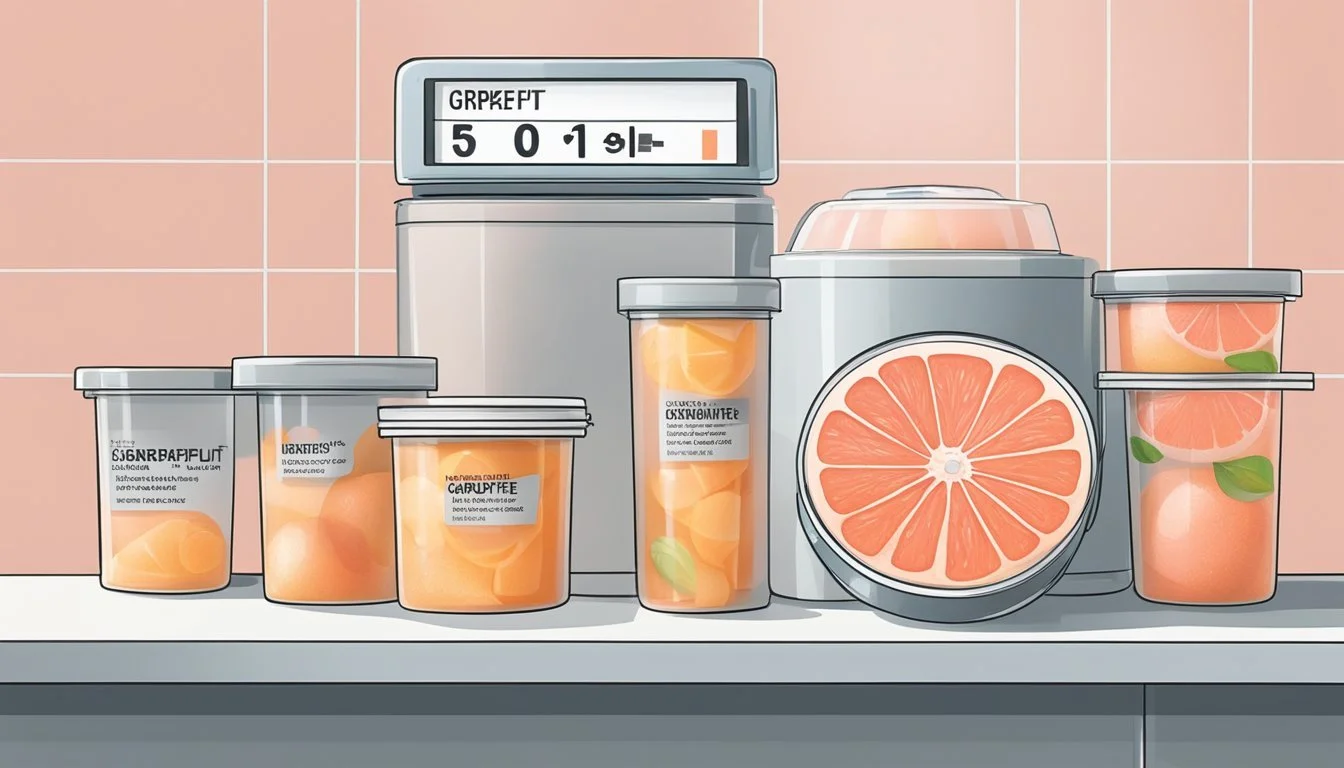How Do You Eat a Grapefruit Sorbet?
Unveiling the Best Techniques
Grapefruit sorbet is a refreshing dessert that captures the essence of summer in every scoop. This frozen delicacy merges the tangy, slightly bitter taste of grapefruit with the sweet, icy texture of traditional sorbets. It is a popular choice for those looking to cleanse the palate or enjoy a light, citrusy treat on a hot day.
The process of eating a grapefruit sorbet is straightforward and allows for personal preferences. Typically served in chilled bowls or glasses, this dessert can be savored slowly to fully appreciate the complex flavors of grapefruit. The sorbet's smooth, granular consistency offers a unique sensory experience, different from ice cream or gelato, making it a distinctive choice for dessert enthusiasts.
Selecting grapefruit sorbet as a dessert option not only promises a delightful taste but also a visually appealing presentation. The vibrant pink or ruby color, characteristic of grapefruit, enhances the dessert experience, inviting indulgence. Whether as a palate cleanser, a stand-alone treat, or an accompaniment to other desserts, grapefruit sorbet stands out for its ability to refresh and satisfy.
Understanding Sorbet
When indulging in a grapefruit sorbet, one is embracing a frozen treat that is both tangy and refreshing, offering a palate-cleansing experience often enjoyed in warmer months like summer. This section examines the fundamentals of sorbet and its culinary role.
Defining Sorbet
Sorbet is a frozen dessert made primarily from fruit puree, water, and sugar. Unlike ice cream, it does not typically contain dairy, making it a lighter, often fruitier alternative in the realm of frozen treats.
Sorbet vs. Ice Cream
The primary difference between sorbet and ice cream is texture and ingredients. Sorbet is dairy-free and relies on the sugar and fruit foundation to create its structure, while ice cream includes milk or cream, which contributes to its creamier texture and higher calorie count.
The Role of Fruit in Sorbet
Fruit is the star in sorbet, providing both the flavor and natural sugars necessary for its consistency. For grapefruit sorbet, the citrus fruit offers a tangy and slightly bitter taste, which can be balanced with the addition of sugar to suit one's palate.
Health Considerations
Sorbet can be a healthier alternative to ice cream given its absence of dairy and potentially lower calorie count, but that largely depends on the sugar content. For those following diets like paleo, sorbet may be a suitable treat if made with compliant ingredients.
Culinary Uses of Sorbet
Sorbet can serve as a refreshing course in a multi-course meal or as an intermezzo (palate cleanser) between dishes. Grapefruit sorbet, with its citrus notes, works well as a light dessert or a rejuvenating break between heavier flavors, epitomizing a versatile and enjoyable frozen treat.
Grapefruit Sorbet Basics
The making of grapefruit sorbet hinges on a well-crafted recipe, premium quality grapefruits, and precise preparation techniques to achieve the perfect balance of sweetness and tartness. Heritage to the ruby red grapefruit, this sorbet is an exemplary showcase of the fruit's vibrant flavor and refreshing taste.
Classic Grapefruit Sorbet Recipe
To craft a classic grapefruit sorbet, one must:
Dissolve sugar in grapefruit juice over medium heat.
Chill the sweetened juice before churning.
Freeze the mixture after churning until firm.
Key ingredients include freshly squeezed grapefruit juice, sugar, and lemon juice to enhance tartness.
The Importance of Grapefruit Quality
Sorbet's flavor is deeply affected by the quality of grapefruit used. Choose ripe ruby red grapefruits with a rich color and heavy feel, indicating juiciness, to ensure a fresh and authentic grapefruit taste.
Selecting the Right Grapefruit
When selecting grapefruits, one targets ruby red grapefruits that are free of blemishes. The fruit should feel firm yet slightly give under pressure, signaling ripeness and optimal flavor.
Preparation Techniques
To extract the most flavor, use a juicer to press the flesh of the grapefruit, retaining the zest for an intensified grapefruit flavor. During preparation, always stir gently to maintain the integrity of the juice.
Sweetness and Tartness Balance
One crucial aspect of grapefruit sorbet is the equilibrium between sweet and tart. This is achieved by adjusting the sugar and lemon juice quantities accordingly, ensuring a palate-pleasing harmony that characterizes a well-made sorbet.
Making Grapefruit Sorbet
Crafting grapefruit sorbet involves creating a sweet and tangy base, enhancing the flavor profile, and using specific freezing techniques to achieve the perfect texture. This frozen treat requires attention to detail at each step to ensure a refreshing and enjoyable experience.
Creating the Base
To begin, dissolve granulated sugar in water on medium high heat in a saucepan to create a simple syrup. Once the sugar has fully dissolved, remove the mixture from the heat and let it cool. This syrup forms the sweet foundation of the sorbet.
Simple Syrup Recipe:
1 cup water
1 cup granulated sugar
Flavor Enhancement
For a potent citrus flavor, mix the cooled syrup with freshly-squeezed grapefruit juice. Adding lemon juice or zest can introduce a complementary tang. Thoroughly stir the mixture to combine these elements, as the zest particularly imbues the liquid with essential oils, heightening the flavor.
Flavor Additions:
Fresh grapefruit juice to taste
Lemon juice for extra tang (optional)
Zest of 1 grapefruit
Churning and Freezing
Transfer the blend to an ice cream maker and churn it according to the manufacturer's instructions. Churning incorporates air, which is crucial for sorbet's light, texture. Once it reaches the desired consistency, transfer the sorbet to a freezer-safe container and let it freeze until firm, usually about an hour.
Churning Instructions:
Pour mixture into chilled ice cream maker bowl.
Churn until mixture is thick and has a slushy-like consistency.
Freeze: Place in a container and freeze until firm.
Alternative Methods without an Ice Cream Maker
For those without an ice cream maker, an alternative is to pour the mixture into ice cube trays or a shallow dish and freeze until solid. Once frozen, blend the cubes in a food processor or blender until smooth and return it to the freezer. Repeat this process to break the ice crystals, ensuring a smooth texture.
No-Churn Method:
Pour mixture into an ice cube tray or shallow pan and freeze until solid.
Blend the frozen chunks until smooth.
Return to freezer until set.
Each step, from heating the simple syrup to incorporating flavor and achieving the right texture, contributes to creating a refreshing grapefruit sorbet that encapsulates the essence of the citrus fruit.
Serving and Presentation
The art of serving grapefruit sorbet lies in its ability to provide a delicious and refreshing end to a meal. It is essential to serve this frozen treat in a way that enhances its vibrant color and fresh flavors.
Serving Suggestions
Grapefruit sorbet is best served in a chilled dish to maintain its consistency. A clear glass bowl or a stemmed glass can showcase the sorbet's appealing color. To appropriately serve, one should use a spoon to scoop the sorbet into the serving dish ensuring each portion is neither too large nor too small for a dessert. Sorbet is traditionally served in between courses as a palate cleanser or after a meal during the warmer summer months because of its refreshing qualities.
Garnishing Options
To garnish grapefruit sorbet, consider using ingredients that complement its bright, tangy flavor. A sprig of mint leaves can add a pop of color and a refreshing taste, while a sprinkle of grapefruit zest can enhance the citrus notes. For those looking for a contrast in flavors, a small piece of dark chocolate can be placed on the side of the sorbet to create a balance between the bitter and sweet profiles. Keep garnishes simple to let the sorbet itself be the star of the dish.
Storage and Shelf Life
Storing grapefruit sorbet properly ensures that its texture and flavor remain as intended. The shelf life of this frozen treat is significantly impacted by storage methods and conditions.
Best Practices for Storing Sorbet
When storing grapefruit sorbet, one should always use an airtight container with a secure lid to prevent freezer burn and flavor absorption from other foods. Freezing is the recommended method as it preserves the sorbet's smooth and soft texture.
Containers: Opt for containers that are freezer-grade to keep the sorbet well-protected.
Freezer Temperature: Maintain the freezer temperature at 0°F (-18°C) or below for optimal conditions.
Maximizing Freshness
To maximize the grapefruit sorbet's freshness and shelf life, one should try to minimize its exposure to air and temperature fluctuations.
Refreezing: Avoid refreezing sorbet after it has melted, as this can affect the texture and quality.
Serving: Use a scooper or spoon that has been warmed under hot water for a clean scoop that maintains the sorbet's smoothness.
By adhering to these guidelines, grapefruit sorbet can be stored effectively, with a typical shelf life ranging from one to three months when kept consistently frozen and properly sealed.
Nutritional Information
This section provides a detailed analysis of the nutritional elements found in grapefruit sorbet, focusing on its caloric content and the impact of its ingredients on one's diet.
Caloric Content Analysis
Grapefruit sorbet is typically seen as a light and refreshing dessert option. The calorie content is relatively low compared to richer desserts. Serving sizes vary, but a regular serving might typically contain:
Calories: Approx. 100-150 calories per half-cup serving
Carbohydrates: Around 30-40 grams
Sugars: Typically high due to added sugars and natural fruit sugars in the grapefruit juice
It's important for consumers to note that the sweet and tart nature of grapefruit sorbet can be attributed to both the natural sugars found in grapefruit juice and any additional sweeteners used during preparation.
Understanding Ingredients Impact
The primary ingredients of grapefruit sorbet include grapefruit juice, sugar, and occasionally other flavor-enhancers like lemon juice. These ingredients contribute to the following nutritional profile:
Sugar: Key factor for sweetness; impacts caloric and carbohydrate content.
Grapefruit Juice: Contributes natural sugars, flavors, and nutrients like Vitamin C and Vitamin A.
Additives: Some recipes may include additives like Campari or salt, which can alter the nutritional content slightly.
It's beneficial for those seeking a healthier dessert option to be aware of the sugar content as it heavily influences the nutritional value. Grapefruit sorbet can be part of a balanced diet when consumed in moderation and when mindful of its sugar content.
Advanced Techniques and Variations
When crafting a grapefruit sorbet, one has the opportunity to explore a range of flavors and adaptations to cater to different dietary needs. These refinements can transform a simple sorbet into a sophisticated and personalized dessert.
Experimenting with Additional Flavors
To enhance the citrus base of grapefruit sorbet, one might consider integrating complementary flavors. Adding an infusion of fresh herbs such as mint or basil can create a refreshing twist. For those seeking a more layered taste experience, the inclusion of a splash of Campari or another bitter liqueur offers a delightful contrast to the sweet and tangy profile of the sorbet. Lemon juice is frequently used as an additional acidic component to balance the sweetness and intensify the overall citrus flavor.
Herb-infused Grapefruit Sorbet:
Add a handful of fresh mint or basil to the sugar syrup while cooking, strain before chilling.
Spirited Grapefruit Sorbet:
Stir in 2 tablespoons of Campari or Aperol after the sugar has dissolved.
Making Paleo or Sugar-Free Variants
For individuals following a paleo diet or those who wish to reduce their sugar intake, creating a sorbet recipe that complies with these requirements is straightforward. Replacing traditional sugar with natural sweeteners such as honey or pure maple syrup offers a healthier alternative without compromising on taste.
Paleo-friendly Grapefruit Sorbet:
Use 3 tablespoons of honey in lieu of sugar.
Incorporate 1/2 cup of coconut cream for a creamier texture.
Sugar-Free Grapefruit Sorbet:
Opt for sugar substitutes like stevia or erythritol according to taste.
Introduce other healthy sweet fruits to enhance the sweetness naturally.
By applying these techniques, one can serve a grapefruit sorbet that not only delights the palate but can also be tailored to suit various dietary preferences and explorations in flavor.
Troubleshooting Common Issues
Creating the perfect grapefruit sorbet involves balancing flavor, texture, and sweetness to achieve a refreshing frozen treat. Below are strategies to tackle common dilemmas one might encounter when making grapefruit sorbet.
Sorbet Texture Problems
Sorbet texture should be smooth and soft, yet hold its shape. If the sorbet is too hard or icy, this often indicates insufficient churning or a lack of sugar, which lowers the freezing point. One should ensure they churn the mixture until it reaches a thick consistency before freezing. For those without a machine, stirring the mixture every 30 minutes while it freezes helps break up ice crystals.
Conversely, if the sorbet is too soft, it hasn't been frozen long enough, or the recipe might contain too much sugar or alcohol, both of which impede freezing. Placing the sorbet in a colder part of the freezer or reviewing the sugar ratio in the recipe could help remedy the issue.
Flavor Intensity Adjustments
The intensity of the grapefruit flavor should be forward and noticeable, characterizing the sorbet. If the grapefruit taste is too muted, one might consider increasing the concentration of grapefruit juice or adding some grapefruit zest to the recipe. It's important to taste the mixture before freezing to ensure the citrus flavor shines through adequately.
In contrast, if the flavor is overwhelming, diluting with a simple syrup or increasing the proportion of other ingredients in the recipe can help mellow it out to a more desirable level.
Fixing Overly Sweet or Tart Sorbet
The balance of sweet and tart is crucial in grapefruit sorbet. If it's too sweet, one can add a splash of lemon juice to provide acidity, enhancing the natural tartness of the grapefruit. This modification should be done gradually, tasting along the way to reach the perfect balance.
If the sorbet is too tart, adding more sugar can reduce the sourness. The sorbet should have just enough sweetness to complement the natural tart flavor of the grapefruit without overshadowing it. Remember, the sweetness will taste less intense once the mixture is frozen, so adjust accordingly while the mixture is still liquid.
Essential Equipment and Tools
Making grapefruit sorbet requires specific kitchen appliances, utensils and the proper storage solutions to ensure a smooth and delicious dessert. Each element plays a crucial role in the creation and preservation of sorbet.
Kitchen Appliances for Sorbet
A few key appliances are indispensable for making sorbet at home:
Electric Ice Cream Maker: This appliance churns the sorbet mixture to the right consistency. It's vital for achieving the smooth, icy texture that defines sorbet.
Blender or Juicer: To extract fresh grapefruit juice, one can use either a blender or a juicer. The goal is to obtain a smooth liquid without pulp for a refined sorbet.
Utensils and Accessories
Accurate and efficient utensils help streamline the sorbet-making process:
Saucepan: A medium saucepan is crucial for dissolving sugar into the grapefruit juice, creating a sweet syrup base.
Whisk: Essential for stirring and ensuring the sugar completely dissolves without clumping.
Spoon: For mixing the sorbet mixture and incorporating all ingredients thoroughly.
Bowl: A large bowl is necessary to combine and refrigerate the sorbet mixture before churning.
Choosing the Right Storage Containers
Proper storage is key to maintaining the sorbet's texture and flavor:
Airtight Container or Loaf Pan: One should transfer the churned sorbet into either an airtight container or a loaf pan. This aids in preventing ice crystals from forming atop the sorbet.
Lid: If using a loaf pan, it must be covered tightly with plastic wrap or a lid to ensure freshness and avoid freezer burn.
Each piece of equipment and tool is an integral part of the sorbet-making process, from preparing the mixture to freezing it to perfection. They ensure the sorbet can be stored effectively to enjoy its full flavor and ideal texture.
Exploring Cultural Context
The consumption of grapefruit sorbet varies across different cultures and regions, garnering a place of significance in the culinary world.
Sorbet in Different Cuisines
Sorbet, a frozen treat often enjoyed for its refreshing qualities, is present in multiple cuisines. In American and European dining, sorbet can serve as a palate cleanser or intermezzo between courses, or as a light dessert. The flavor profile can range from light and subtle to bold and aromatic, with grapefruit being a popular choice for its tangy and slightly bitter taste.
American cuisine: Grapefruit sorbet is often made with ruby red grapefruit for its sweet and vibrant character.
European traditions: The emphasis might be on the sorbet's role as a course transitioning the palate from savory to sweet.
Seasonal and Regional Variations
The enjoyment of grapefruit sorbet also hinges on seasonal and regional preferences.
Summer: In warmer climates and during summer months, the demand for this frozen treat peaks, as it provides a refreshing respite from the heat.
Winter: In contrast, certain regions embrace consuming citrus-based sorbets like grapefruit in winter, when citrus fruits are at their peak of freshness.
Tropical regions are known to embrace fruit sorbets year-round due to the constant availability of fresh produce.
Historical Significance of Sorbet
Sorbet has a rich history tracing back to ancient times, where it was cherished as a luxury because of the difficulty in procuring ice.
History: The concept of sorbet is believed to have been introduced to Europe from the Middle East where it was initially savored as a refreshment.
Dessert evolution: Over time, sorbet has evolved, with grapefruit sorbet becoming a modern twist on traditional flavors.
In exploring the cultural context of grapefruit sorbet, one can appreciate the diverse ways this frozen treat is integrated into different dining experiences, adapted to seasonal ingredients, and how its historical evolution has maintained its status as a cherished dessert.








